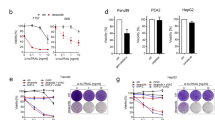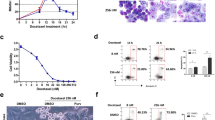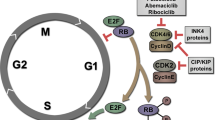Abstract
The inhibition of apoptosis is generally believed to be a major determinant of resistance to chemotherapy. However, recent findings have shown that caspase inhibitors do not protect cancer cells from death by cytotoxic agents, but may switch drug-induced apoptosis to an alternative ‘default death’. The primary goals of this study were to determine the major characteristics of the ‘default death’ and the mechanism by which this switch is activated. For this purpose, we first investigated putative cell death modes induced by doxorubicin. Molecular markers associated with these death modes were utilized to identify the default death resulting from the inhibition of apoptosis. Our findings demonstrated that doxorubicin induced at least three distinct types of cell death, senescence, apoptosis and a type of necrosis, which were concentration dependent. Specific molecular markers such as p21/WAF1, activated caspase-3 and activated Akt were associated with these death modes. The pan-caspase inhibitor (Q-VD-OPH) greatly reduced doxorubicin-induced caspase-3 activation but did not protect cells against drug toxicity. The combination of doxorubicin and Q-VD-OPH caused an increased expression of p21/WAF1 and senescence -associated -β-galactosidase activity, but did not alter Akt activation. Collectively, these findings suggest that the inhibition of apoptosis may lead to an increased expression of cell cycle inhibitors and cellular senescence.
This is a preview of subscription content, access via your institution
Access options
Subscribe to this journal
Receive 50 print issues and online access
$259.00 per year
only $5.18 per issue
Buy this article
- Purchase on Springer Link
- Instant access to full article PDF
Prices may be subject to local taxes which are calculated during checkout





Similar content being viewed by others
References
Ahrendt SA, Brown HM, Komorowski RA, Zhu YR, Wilson SD, Erickson BA, Ritch PS, Pitt HA and Demeure MJ . (2000). Surgery, 128, 520–530.
Borst P, Borst J and Smets LA . (2001). Drug Resist. Update, 4, 129–131.
Brognard J, Clark AS, Ni Y and Dennis PA . (2001). Cancer Res., 61, 3986–3997.
Brown JM and Wouters BG . (1999). Cancer Res., 59, 1391–1399.
Chang BD, Swift ME, Shen M, Fang J, Broude EV and Roninson IB . (2002). Proc. Natl. Acad. Sci. USA, 99, 389–394
Cohen GM . (1997). Biochem. J., 326, 1–16.
Dimri GP, Lee X, Basile G, Acosta M, Scott G, Roskelley C, Medrano EE, Linskens M, Rubelj I and Pereira-Smith O . (1995). Proc. Natl. Acad. Sci. USA, 92, 9363–9367.
Emran MA, Rebbaa A and Mirkin, BL . (2001). Cancer Lett., 182, 53–59.
Ferrandina G, Stoler A, Fagotti A, Fanfani F, Sacco R, De Pasqua A, Mancuso S and Scambia G . (2000). Int. J. Oncol., 17, 1231–1235.
Friesen C, Herr I, Krammer PH and Debatin KM . (1996). Nat. Med., 2, 574–577.
Friesen C, Fulda S and Debatin KM . (1997). Leukemia, 11, 1833–1841.
Friesen C, Fulda S and Debatin KM . (1999). Leukemia, 13, 1854–1858.
Han Z, Wei W, Dunaway S, Darnowski JW, Calabresi P, Sedivy J, Hendrickson EA, Balan KV, Pantazis P and Wyche JH . (2002). J. Biol. Chem., 277, 17154–17160.
Hartmann A, Troadec JD, Hunot S, Kikly K, Faucheux BA, Mouatt-Prigent A, Ruberg M, Agid Y and Hirsch EC . (2001). J. Neurosci., 21, 2247–2255.
Jin YH, Yoo KJ, Lee YH and Lee SK . (2000). J. Biol. Chem., 275, 30256–30263.
Kapranos N, Stathopoulos GP, Manolopoulos L, Kokka E, Papadimitriou C, Bibas A, Yiotakis J and Adamopoulos G . (2001). Anticancer Res., 21, 521–528.
Kim SO and Han J . (2001). J. Endotoxin. Res., 7, 292–296.
Kim TH, Zhao Y, Barber MJ, Kuharsky DK and Yin XM . (2000). J. Biol. Chem., 275, 39474–39481.
Kojima H, Endo K, Moriyama H, Tanaka Y, Alnemri ES, Slapak CA, Teicher B, Kufe D and Datta R . (1998). J. Biol. Chem., 273, 16647–16650.
Li H, Zhu H, Xu CJ and Yuan J . (1998). Cell, 94, 491–501.
Lowe SW, Ruley HE, Jacks T and Housman DE . (1993). Cell, 74, 957–967.
Luschen S, Ussat S, Scherer G, Kabelitz D and Adam-Klages S . (2000). J. Biol. Chem., 275, 24670–24678.
Martinsson P, Liminga G, Nygren P and Larsson R . (2001). Anticancer Drugs, 12, 699–705.
Nakashima S, Natsugoe S, Matsumoto M, Kijima F, Takebayashi Y, Okumura H, Shimada M, Nakano S, Kusano C, Baba M, Takao S and Aikou T . (2000) Anticancer Res., 20, 1933–1937.
Rebbaa A, Chou PM, Emran M and Mirkin BL . (2001). Cancer Chemother. Pharmacol., 48, 423–428.
Roninson IB . (2002). Drug Resist. Updates., 252, 1–5.
Roninson IB, Broude EV and Chang BD . (2001). Drug Resist. Updates, 4, 303–313.
Schmitt CA, Fridman JS, Yang M, Lee S, Baranov E, Hoffman RM and Lowe SW . (2002). Cell, 109, 335–346.
Serrano M, Lin AW, McCurrach ME, Beach D and Lowe SW . (1997). Cell, 88, 593–602.
te Poele RH, Okorokov AL, Jardine L, Cummings J and Joel SP . (2002). Cancer Res., 62, 1876–1883.
Yaginuma H, Shiraiwa N, Shimada T, Nishiyama K, Hong J, Wang S, Momoi T, Uchiyama Y and Oppenheim RW . (2001). Mol. Cell. Neurosci., 18, 168–182.
Zhou H, Li XM, Meinkoth J and Pittman RN . (2000). J. Cell. Biol., 151, 483–494.
Zunino F, Perego P, Pilotti S, Pratesi G, Supino R and Arcamone F . (1997). Pharmacol. Ther., 76, 177–185.
Acknowledgements
We thank Roberta Gerard and Sandra Clark for their assistance in the preparation of this manuscript. This investigation was supported in part by the Illinois Department of Public Aid (AR), the North Suburban Medical Research Junior Board (AR and BLM) the Anderson Foundation (BLM) and the Medical Research Institute Council (BLM).
Author information
Authors and Affiliations
Corresponding author
Rights and permissions
About this article
Cite this article
Rebbaa, A., Zheng, X., Chou, P. et al. Caspase inhibition switches doxorubicin-induced apoptosis to senescence. Oncogene 22, 2805–2811 (2003). https://doi.org/10.1038/sj.onc.1206366
Received:
Revised:
Accepted:
Published:
Issue Date:
DOI: https://doi.org/10.1038/sj.onc.1206366
Keywords
This article is cited by
-
Cellular senescence triggers intracellular acidification and lysosomal pH alkalinized via ATP6AP2 attenuation in breast cancer cells
Communications Biology (2023)
-
BID expression determines the apoptotic fate of cancer cells after abrogation of the spindle assembly checkpoint by AURKB or TTK inhibitors
Molecular Cancer (2023)
-
Pyrroline-5-carboxylate synthase senses cellular stress and modulates metabolism by regulating mitochondrial respiration
Cell Death & Differentiation (2021)
-
B7-H3 suppresses doxorubicin-induced senescence-like growth arrest in colorectal cancer through the AKT/TM4SF1/SIRT1 pathway
Cell Death & Disease (2021)
-
Integrin α6β4-Src-AKT signaling induces cellular senescence by counteracting apoptosis in irradiated tumor cells and tissues
Cell Death & Differentiation (2019)



